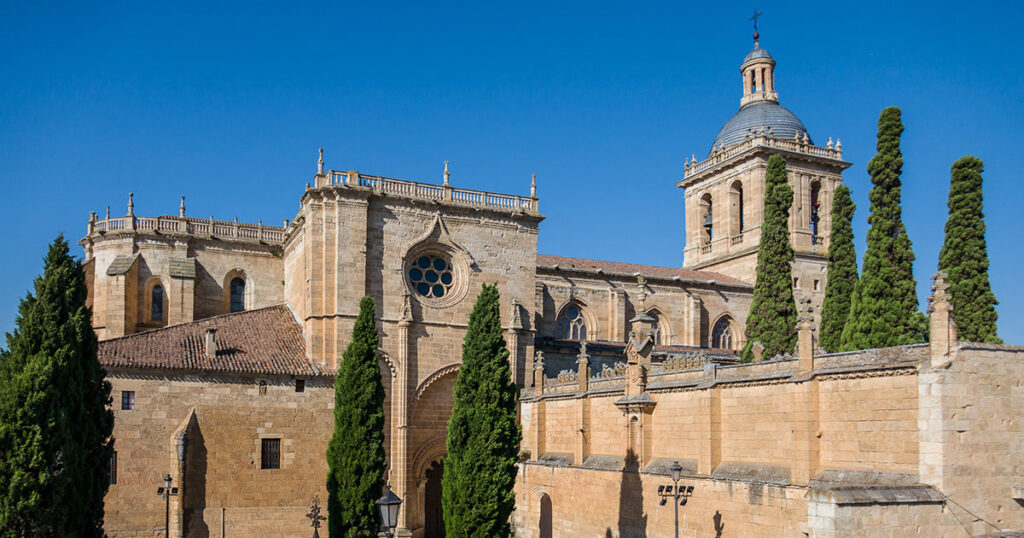
Oviedo, the capital of Asturias and one of the three large cities in the autonomous region, sits on a hill with mountains on three sides. It was once the seat of the Kingdom of Asturias, when Asturias was the only region not part of Moorish Spain, and the city boasts many fine examples of pre-Romanesque architecture, dating from medieval times and built at the orders of one king or another. Five are UNESCO World Heritage sites. What is the city like? Old, beautiful, and quaint in spots—certain streets, certain buildings, certain views—but by no means uniformly lovely. The loveliest city I’ve seen so far in Spain is Ciudad Rodrigo, 15 miles from the Portuguese border, where almost no new building rises from within the old walls. It is a picture-book city center of stone buildings, stone columns and colonnades, stone arches and stone stairs, wrought iron balconies and ancient wood, coats of arms from many centuries back, and narrow streets. All within an enclosing wall that is nearly 1.5 miles long, as high as 42 feet in places, and eight feet wide. Seven gates allow entrance. Massive doors on gigantic hinges to swing closed and keep out the invaders and a dry ditch that once was a moat complete the illusion of an impregnable stronghold, immune to time and corruption.
In Oviedo, in contrast, old and new stand side-by-side in a crowded jumble of dull brass and bright glitz, brick and tile, plastic and stone. Though the city is nearly 20 times larger than Ciudad Rodrigo, it still ranks for Spaniards as a small town. Madrid, Seville, Barcelona, Valencia—those are cities, with their millions of inhabitants. Everything else, according to the friends, acquaintances, and students I’ve talked to over the years, everything else—including their own city of Gijón, the largest in Asturias—is a backwater.
If a city like Oviedo, with its university, cathedrals, art museums and opera, cultural centers and history, and impressive pre-Romanesque architecture, is the sticks, then what are the outlying villages that dot the mountains all around the city, sometimes consisting of no more than three or four houses, where nothing important ever happened and from where nobody important ever came? These collections of houses and barns, fields and farm animals, seem from one perspective to be no more than scattered debris, leftover, worth little, like the chaff that blows off a wagonload of straw. Yet many of these rudimentary dwellings have been rescued from ruin and rebuilt, enlarged, and enclosed by stone walls that cost more to construct than the whole house is worth. Make that was worth. Because the labor that goes into rebuilding the old structures quadruples their value in no time. And if something of the old craftsmanship is preserved, then the homes, often the weekend retreats of city dwellers, are worth even more. I was gladdened recently in the village of Pedroveya, population 13 at the last census, to see one old home with firewood piled under the hórreo and smoke rising from the chimney, and astonished to see the neglect in a similar structure across the way, woodwork unpainted, balcony sagging, roof tiles a jumble. At least it looked habitable, and perhaps no worse than when whole families—whole clans—pitched in to keep the place up and make a livelihood. A less-than-pristine home might not matter when all around, whichever way you turned, are incredible vistas of green valleys and snowy peaks.
Like that neglected house, hundreds more in Asturias are waiting to be restored with paint and a new roof. Others are more decrepit. Abandoned, many of them, not beyond repair but requiring far too much work to make it worth anyone’s while. And yet, viewing the details such as the marks from the stonemason’s chisel on the cornerstones and imagining the effort put into making these homes, you feel they should be brought back from the precipice of ruin as one of the aged donkeys in a field should be led back to the barn.
When admiring the architecture in Ciudad Rodrigo this past fall, I marveled at so many gorgeous stone carvings. Much of what I oohed and ahhed at was not a particular monument, per se, but the general caliber of workmanship on view. Not a one-of-a-kind cathedral but an otherwise simple doorway, huge and arched and carved. Could you even hire someone to execute such detailed work these days? Should those buildings crumble, we will not see their like again. I thought the same thing as I poked around in the ruin of a stone house on a narrow road descending from Pedroveya, in the mountains circling Oviedo. Nothing to be salvaged there, I concluded on entering: the wooden beams overhead were warped by water leaking in from the decrepit roof, the hinges on the Dutch door were pulling loose from the frame and the door was sagging, and the wooden stairs leading to a second floor looked too flimsy to trust. But as I stepped back out through the doorway, I noted the massive stone that was the threshold, smooth as marble, extending under and supporting the stone doorframe, which still held together, as did the front wall of the house. The corner stones of that wall were giant: oblong stones, one laid atop another in alternating short and long sides. From ground to second-story roof, the corner was perfectly plumb, not an inch out of true. You could rebuild the house from that existing, stalwart corner. But it would take a fortune to raise all the walls again, replace the roof, and reconstruct the hórreo, even without rebuilding that corner. And another fortune to make it cozy inside on these wet, chilly days. Just like the monuments, when the old houses crumble, we will not see their like again. Or the people who came from nowhere and lived there, making it for a while the center of something.

